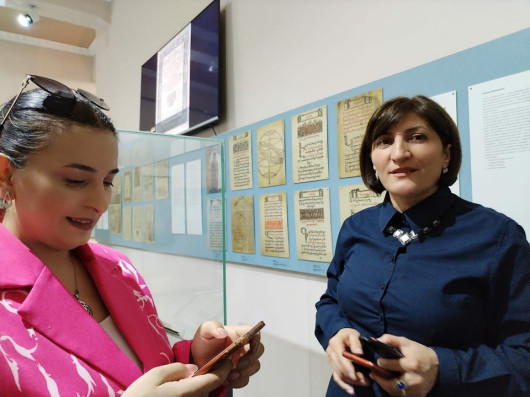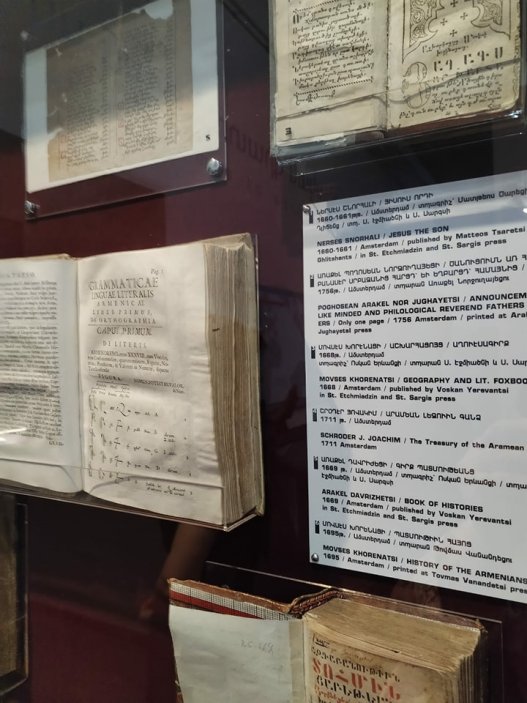
USD 402.56, EUR 440.64, RUB 4.58, GBP 505.01
+22 °C, +17 °C ... +32 °C Vaghy:+32 °C
+22 °C, +17 °C ... +32 °C Vaghy:+32 °C
HAY GRATPUTYAN PATMUTYUNY EREVANI GRATPUTYAN TANGARANUM
10:40, 07.06.2024
259 | 0

HAY GRATPUTYAN PATMUTYUNY EREVANI GRATPUTYAN TANGARANUM Der 2017 tvakani septemberi 25-in Hayastani azgayin gradaranum, tnoren b․g․t․ Anna Chulyan, bacvec taracashrjanum ir tesaki mej ezaki Gratputyan tangarany, vori 6 srahnerum nerkayacvac en naxagrayin shrjanic minchev girn ynkac zhamanakahatvacum steghcvac gravor mshakuyti nmushner: zhayrapatkerner, sepagir ardzanagrutyunner։ Tangarany gita-krtakan hskayacaval gorcuneutyun e irakanacnum։ Gratputyan tangarani masin teghekatvutyunn arka e voch miayn hay tangaranayin mshakuyti aylev mijazgayin mshakuyti teghekatvakan ejerum։ Gradarani ashxatakicneri voghj kazmy tangarani varich Balasan Harutyunyani anmijakan ghekavarutyamb ev masnakcutyamb sirov u patrastakamutyamb en yndunum tarber tariqi hyurerin ev ognum nranc teghaphoxvelu mi zarmanahrash ashxarh, vorin arnchvely voch miayn tchanachoghakan hetaqrqir horizonner e bacum, aylev pattcharum e mec geghagitakaan hatchuyq։ Tangarany parunakum e ezaki cucadrutyunner, inchpes harust grakan zharangutyan masin patmogh, aynpes el gratputyan zanazan sarqavorumneri, dranc ashxatanqi ev ashxatanqy kazmakerpoghneri masin։ Teghekatvutyunn aynqan mec e, vor arajin hayacqic tvum e te mtapahely dyurin chi lini։ Tangarann ashxatum e tangaranayin rezhimov, masnakcum e tangaranayin gisherva mijocarumnerin, arhestavarzh ashxatakicnery mi qani lezunerov anchaph hetaqrqir en nerkayacnum cucanmushner, evropayum tpagrvac tankarzheq qarteznery, ezaki grqery u amsagrer, tpagrvac nmushner, vorn hatchax zugakcvum e dasaxosutyunnerov: arajadem texnologianeri kirarmamb: Mshtakan cucadrutyunic baci, tangarann ir hatchaxordneri hamar irakanacnum e arzheqavor tangarani masin patmogh tchanachoghakan filmeri cucadrutyun, voroncic kareli e nshel «Bacahaytir Hayastany», «Hay grqi tchanaparhy 16-18rd dd» filmery։ Verjins patmum e hay grqi tpagrutyan kayacman ughu masin: Mxitarean Miabanutyunic Surb Ghazar Venetik։ Cucanmushneri mej yurahatuk tegh unen hay grqi tpagrutyan bnagavarum Hakob Meghaparti katarac ashxatanqy nshogh, 1512 tiv, cucanmushnery։ Tangarani ashxatakicnery mec hpartutyamb en lusabanum hay tpagrutyan ancac ughin։ Hay-iranakan mshakutayin kapery nerkayacvac en arandznahatuk xnamqov, cucanmushnery patmum en Andre Sevrugyani: Darvishi ashxatanqneri masin։ Tangaran-dproc hamagorcakcutyan sahmannerum, inchpes patmecin tangarani ashxatakicnery, dprocnerin trvum en bazmaki aycelutyan hatuk anvtchar aycetomser։ Tchanachoghakan shrjayceri mijocov ashakertnery bacahaytum en hayeren arajin tpagir girqn u amsagiry, hay gratputyan aveli qan 510-amya patmutyuny, arajin Astvacashunchn u qartezy, phaytaphoragir taxtaknern u klishenery։ Evropakan bazmativ qaghaqnerum steghcvac tparannery hratarakum ein grqer u parberakanner, vortegh kareli e gtnel voch miayn hay heghinakneri gorcer aylev evropaci heghinakneri dasakan ashxatutyunneri vorakyal targmanutyunner։ Hay gratputyuny caghkum er aprum Evropayi srtum։ Steghcvecin bazmativ tpagratner։ Orinak, Marselum haykakan tparany sksel e gorcel 1673t., isk Triesteic bervac tpagrakan meqenayov ev haykakan tarerov himnadrvum e nor tparan varzharanin kic։ Tangaranum cucadrvac ashxarhum qaj haytni qartezy patrastvel e Amsterdamum hayeri koghmic 1695 tvin։ 18-rd dari skzbin Amsterdami haykakan tparany sharunakum er katarelagorcvel tpagrakan arvesti mej ev kartch zhamanakahatvacum minchev 1717 tvakany luys e tesnum 14 anun hratarakutyun, voroncic arandznapes hishatakeli e evropaci arajin hayaget Yohan Yoaxim Shryoderi (1680 – 1756tt.) grabarin nvirvac «Aramean lezuin gandz», 1711t., (Thesaurus linguae armenicae) hayeren-latineren hayagitakan ashxatutyuny, vory cucadrvac e tangarani «Hay gratputyan sphyurqy» srahum: Arevmtyan Hayastani bazmativ qaghaqnerum ev vanqerin kic mec zargacum e aprel gratputyuny: shnorhiv hay mtavorakanneri janqeri ev evropayic bervac sarqeri։ Nor texnologianerov hagecac HH Gratputyan tangarany 2018 tvakanic dardzel e Evropakan gratputyan tangaranneri asociaciayi andam, ayn aylyntranqayin krtakan interaktiv mijavayr e te aybubeny nor-nor sovorogh arajin dasarancu, te usanoghneri, te hayoc tpagir mtqov hetaqrqrvoghneri hamar: Hetaqrqrakan e, vor tangarany mec hetaqrqrutyun e nerkayacnum artasahmanci usanoghneri ev zbosashrjikneri hamar, voronq canotanalov nmushnerin bacahaytum en Hayastany yurovi։ Hatuk NidOragri hamar Hayastani mayraqaghaq Erevanic Naira Gasparyan, b․g․t․, EPH Docent THE HISTORY OF ARMENIAN TYPOGRAPHY IN YEREVAN MUSEUM OF TYPOGRAPHY For NidOragir From Yerevan, the capital of Armenia Naira Gasparyan, PhD, YSU Associate Professor On September 25, 2017, the National Library of Armenia, headed by Anna Chulyan (Ph.D), opened the Museum of Typography, unique in its kind in the region, presenting exhibits of the written culture created from the pre-writing period to petroglyphs and cuneiform inscriptions in its 6 halls. The museum, carries out huge scientific and educational activities. The information about the Museum of Typography is available not only on the information pages of the Armenian museum culture, but also on the information pages of the international culture. The entire staff of the library and the manager of the museum Balasan Harutyunyan, welcome museum guests of different ages with love and willingness and help them move to the amazing world, which not only opens up interesting cognitive horizons, but also secures great aesthetic pleasure. The museum contains unique exhibits, both about the rich typography heritage, and about various printing equipment, their work and the printing work organizers. The information is so huge that at first sight it seems not to be easily memorized. The museum works in the ordinary museum mode, participates in "museum night" events, professional guides in several languages present interesting exhibits, expensive maps printed in Europe, unique books and magazines, printed material, and often deliver their speeches and lectures using advanced technologies. In addition to the permanent exhibition, the museum shows informative films for its visitors about the valuable museum exhibits, Armenian writing and publishing culture, among which we can mention the films "Discover Armenia", "The Way of the Armenian Book 16-18th Centuries". The latter tells us about the path to the establishment of Armenian book printing, from the Mkhitarian Congregation to St. Lazarus Venice, mentioning the year of 1512 to mark the work done by Hakob Meghapart in the field of Armenian book printing. The employees of the museum present speeches covering the path of Armenian printing with great pride. Armenian-Iranian cultural ties are presented with special care, the exhibits tell us about the works of Andre Sevrugyan, Darvish. Within the framework of museum-school cooperation, as a museum employee said, schools are given special free tickets for multiple visits. Through cognitive tours, students discover the first printed book and magazine in Armenian, the more than 510-year history of Armenian printing, the first Bible and map, woodcut plates and clichés. The activity of Armenian printing houses in many European cities was marked by printing books and periodicals where one could find not only works by Armenians but also high quality translations of classical works by European authors. Armenian publishing began to blossom in the heart of Europe. There appeared many publishing houses in Europe. For example, the Armenian printing house started working in Marseille in 1673, and a new printing house was founded, next to the school, as soon as some printing equipment and Armenian letters were brought from Trieste. The world-famous map displayed in the museum was made by Armenians in Amsterdam in 1695. At the beginning of the 18th century, the Armenian printing house in Amsterdam continued to improve the art of printing and in a short period of time until 1717, 14 publications were published, among which the "Treasure of the Aramaic Language" dedicated to the collection of the first European Armenologist Johann Joachim Schröder (1680 - 1756) is worth mentioning. In 1711, (Thesaurus linguae armenicae) the Armenian-Latin Armenian work, which is exhibited in the museum's "Diaspora of Armenian Literature" hall was published. In many places and monasteries of Western Armenia, printing developed greatly thanks to the efforts of Armenian intellectuals and devices brought from Europe. Equipped with new technologies, the RA Museum of Typography has become a member of the Association of European Typography Museums since 2018. It is an alternative educational interactive environment for first-graders who are just learning the alphabet, students, and those interested in the Armenian printed mind. It should also be mentioned that the museum is of great interest to foreign students and tourists, who discover Armenia in their own way by getting to know the magnificent exhibits. |


Mamuli xosnak: Niderlandakan Oragir
Nyuty hraparakvel e Mamuli xosnaki shrjanaknerum:
Kisvir ays nyutov:
Niderlandakan Oragir
13:21, 14.06.2024
240 | 0
13:48, 12.06.2024
367 | 0
12:10, 23.05.2024
384 | 0
13:59, 30.04.2024
477 | 0
19:13, 29.04.2024
460 | 0
14:38, 20.06.2024 - Niderlandakan Oragir
192 | 0
09:00, 21.06.2024 - Hamlet Meliqyan
77 | 0
08:50, 21.06.2024 - soni540kumari
43 | 0
Mamuli xosnakum hraparakvac bolor nyutery entaka en azat hraparakman ev kargavorvum en grancman paymanagrov:
Ayl kayqeric nyuteri artatpumy tuylatrvum e miayn ayn depqum, ete chi hakasum aghbyuri ogtagorcman paymannerin:
Govazdneri bovandakutyan hamar kayqy patasxanatvutyun chi krum:





























